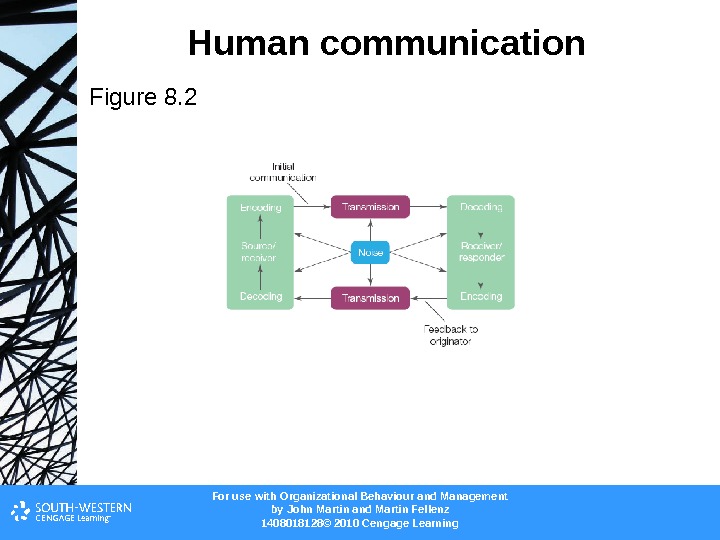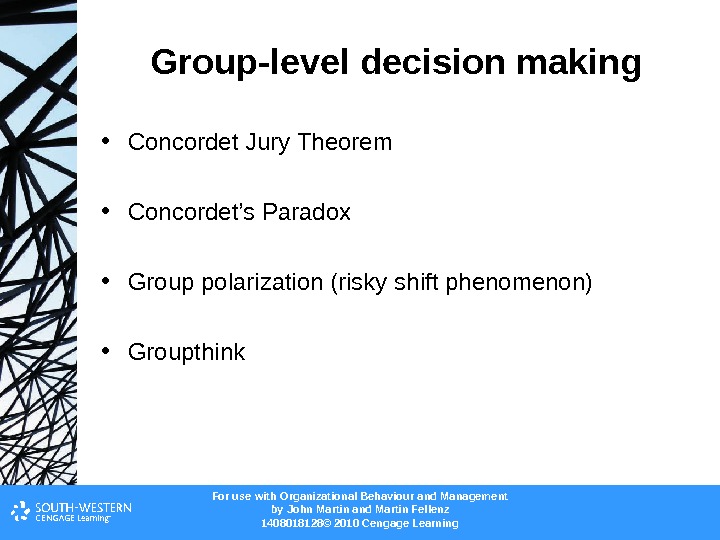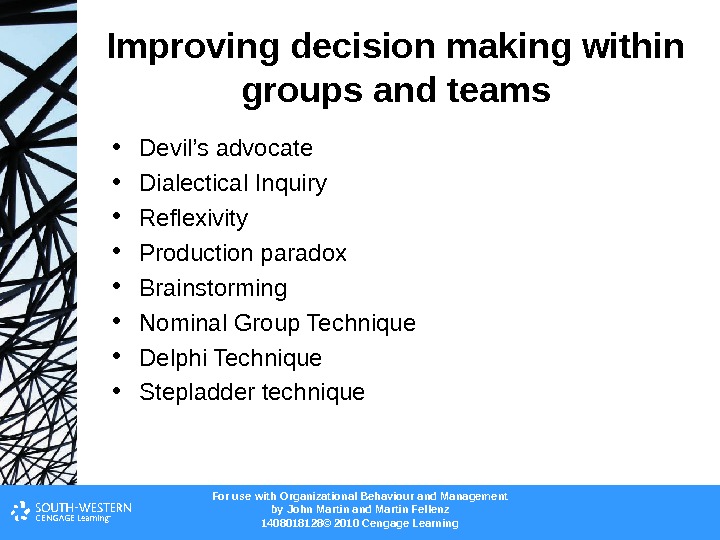For use with Organizational Behaviour and Management b





























ch_8_comms_amp_decis_make_2.ppt
- Размер: 689 Кб
- Количество слайдов: 28
Описание презентации For use with Organizational Behaviour and Management b по слайдам
 For use with Organizational Behaviour and Management b y John Martin and Martin Fellenz 1408018128© 2010 Cengage Learning. COMMUNICATION AND DECISION MAKING Chapter
For use with Organizational Behaviour and Management b y John Martin and Martin Fellenz 1408018128© 2010 Cengage Learning. COMMUNICATION AND DECISION MAKING Chapter
 For use with Organizational Behaviour and Management b y John Martin and Martin Fellenz 1408018128© 2010 Cengage Learning Definitions • Communication — the process by which people convey and receive information to and from each other • Decision making — a process of selecting a particular course of action from among the options available • Problem solving — the activity of generating a solution to a recognized problem
For use with Organizational Behaviour and Management b y John Martin and Martin Fellenz 1408018128© 2010 Cengage Learning Definitions • Communication — the process by which people convey and receive information to and from each other • Decision making — a process of selecting a particular course of action from among the options available • Problem solving — the activity of generating a solution to a recognized problem
 For use with Organizational Behaviour and Management b y John Martin and Martin Fellenz 1408018128© 2010 Cengage Learning. A model of communication • Figure 8.
For use with Organizational Behaviour and Management b y John Martin and Martin Fellenz 1408018128© 2010 Cengage Learning. A model of communication • Figure 8.
 For use with Organizational Behaviour and Management b y John Martin and Martin Fellenz 1408018128© 2010 Cengage Learning. Human communication Figure 8.
For use with Organizational Behaviour and Management b y John Martin and Martin Fellenz 1408018128© 2010 Cengage Learning. Human communication Figure 8.
 For use with Organizational Behaviour and Management b y John Martin and Martin Fellenz 1408018128© 2010 Cengage Learning. Human communication within organizations Figure 8.
For use with Organizational Behaviour and Management b y John Martin and Martin Fellenz 1408018128© 2010 Cengage Learning. Human communication within organizations Figure 8.
 For use with Organizational Behaviour and Management b y John Martin and Martin Fellenz 1408018128© 2010 Cengage Learning. The two dimensions of communicati ons • Figure 8.
For use with Organizational Behaviour and Management b y John Martin and Martin Fellenz 1408018128© 2010 Cengage Learning. The two dimensions of communicati ons • Figure 8.
 For use with Organizational Behaviour and Management b y John Martin and Martin Fellenz 1408018128© 2010 Cengage Learning. Increasing number and complexity of communication linkages
For use with Organizational Behaviour and Management b y John Martin and Martin Fellenz 1408018128© 2010 Cengage Learning. Increasing number and complexity of communication linkages
 For use with Organizational Behaviour and Management b y John Martin and Martin Fellenz 1408018128© 2010 Cengage Learning. Communications within organizations Communications in large organizations needs to be managed carefully: • Limitation • Procedure • Teamwork • Automation • Separation • Jargon
For use with Organizational Behaviour and Management b y John Martin and Martin Fellenz 1408018128© 2010 Cengage Learning. Communications within organizations Communications in large organizations needs to be managed carefully: • Limitation • Procedure • Teamwork • Automation • Separation • Jargon
 For use with Organizational Behaviour and Management b y John Martin and Martin Fellenz 1408018128© 2010 Cengage Learning. Communications processes Communication — four general functions: • Information processing • Co-ordination • Visioning • Personal expression Methods of communication: • Written • Oral • Non-verbal • Electronic
For use with Organizational Behaviour and Management b y John Martin and Martin Fellenz 1408018128© 2010 Cengage Learning. Communications processes Communication — four general functions: • Information processing • Co-ordination • Visioning • Personal expression Methods of communication: • Written • Oral • Non-verbal • Electronic
 For use with Organizational Behaviour and Management b y John Martin and Martin Fellenz 1408018128© 2010 Cengage Learning. The manager’s communication network • Figure 8.
For use with Organizational Behaviour and Management b y John Martin and Martin Fellenz 1408018128© 2010 Cengage Learning. The manager’s communication network • Figure 8.
 For use with Organizational Behaviour and Management b y John Martin and Martin Fellenz 1408018128© 2010 Cengage Learning. Seating arrangements for effect • Figure 8.
For use with Organizational Behaviour and Management b y John Martin and Martin Fellenz 1408018128© 2010 Cengage Learning. Seating arrangements for effect • Figure 8.
 For use with Organizational Behaviour and Management b y John Martin and Martin Fellenz 1408018128© 2010 Cengage Learning. Non-verbal communications • Table 8.
For use with Organizational Behaviour and Management b y John Martin and Martin Fellenz 1408018128© 2010 Cengage Learning. Non-verbal communications • Table 8.
 For use with Organizational Behaviour and Management b y John Martin and Martin Fellenz 1408018128© 2010 Cengage Learning. Listening Skill Sets • Table 8.
For use with Organizational Behaviour and Management b y John Martin and Martin Fellenz 1408018128© 2010 Cengage Learning. Listening Skill Sets • Table 8.
 For use with Organizational Behaviour and Management b y John Martin and Martin Fellenz 1408018128© 2010 Cengage Learning. Guidelines for providing effective interpersonal feedback • Table 8.
For use with Organizational Behaviour and Management b y John Martin and Martin Fellenz 1408018128© 2010 Cengage Learning. Guidelines for providing effective interpersonal feedback • Table 8.
 For use with Organizational Behaviour and Management b y John Martin and Martin Fellenz 1408018128© 2010 Cengage Learning. Guidelines for receiving interpersonal feedback • Table 8.
For use with Organizational Behaviour and Management b y John Martin and Martin Fellenz 1408018128© 2010 Cengage Learning. Guidelines for receiving interpersonal feedback • Table 8.
 For use with Organizational Behaviour and Management b y John Martin and Martin Fellenz 1408018128© 2010 Cengage Learning. The Johari Window and the processes for increasing awareness (1) • Figure 8. 8 a
For use with Organizational Behaviour and Management b y John Martin and Martin Fellenz 1408018128© 2010 Cengage Learning. The Johari Window and the processes for increasing awareness (1) • Figure 8. 8 a
 For use with Organizational Behaviour and Management b y John Martin and Martin Fellenz 1408018128© 2010 Cengage Learning. The Johari Window and the processes for increasing awareness (2) Figure 8. 8 b
For use with Organizational Behaviour and Management b y John Martin and Martin Fellenz 1408018128© 2010 Cengage Learning. The Johari Window and the processes for increasing awareness (2) Figure 8. 8 b
 For use with Organizational Behaviour and Management b y John Martin and Martin Fellenz 1408018128© 2010 Cengage Learning. Factors influencing decision processes and outcomes • Figure 8.
For use with Organizational Behaviour and Management b y John Martin and Martin Fellenz 1408018128© 2010 Cengage Learning. Factors influencing decision processes and outcomes • Figure 8.
 For use with Organizational Behaviour and Management b y John Martin and Martin Fellenz 1408018128© 2010 Cengage Learning. Decision making models • Programmed and non-programmed decision making • Rational model • Bounded rationality model
For use with Organizational Behaviour and Management b y John Martin and Martin Fellenz 1408018128© 2010 Cengage Learning. Decision making models • Programmed and non-programmed decision making • Rational model • Bounded rationality model
 For use with Organizational Behaviour and Management b y John Martin and Martin Fellenz 1408018128© 2010 Cengage Learning Heuristics refer to mental shortcuts or cognitive ‘rules of thumb’ Judgemental heuristics, biases and errors: • availability heuristic • representativeness heuristic • prospect theory • endowment effect • anchoring and adjustment effects • illusion of control • hindsight bias • implicit favourite bias • nonrational escalation of commitment
For use with Organizational Behaviour and Management b y John Martin and Martin Fellenz 1408018128© 2010 Cengage Learning Heuristics refer to mental shortcuts or cognitive ‘rules of thumb’ Judgemental heuristics, biases and errors: • availability heuristic • representativeness heuristic • prospect theory • endowment effect • anchoring and adjustment effects • illusion of control • hindsight bias • implicit favourite bias • nonrational escalation of commitment
 For use with Organizational Behaviour and Management b y John Martin and Martin Fellenz 1408018128© 2010 Cengage Learning. Group-level decision making • Concordet Jury Theorem • Concordet’s Paradox • Group polarization (risky shift phenomenon) • Groupthink
For use with Organizational Behaviour and Management b y John Martin and Martin Fellenz 1408018128© 2010 Cengage Learning. Group-level decision making • Concordet Jury Theorem • Concordet’s Paradox • Group polarization (risky shift phenomenon) • Groupthink
 For use with Organizational Behaviour and Management b y John Martin and Martin Fellenz 1408018128© 2010 Cengage Learning. Symptoms of Groupthink • Table 8.
For use with Organizational Behaviour and Management b y John Martin and Martin Fellenz 1408018128© 2010 Cengage Learning. Symptoms of Groupthink • Table 8.
 For use with Organizational Behaviour and Management b y John Martin and Martin Fellenz 1408018128© 2010 Cengage Learning. Preventing groupthink • Figure 8.
For use with Organizational Behaviour and Management b y John Martin and Martin Fellenz 1408018128© 2010 Cengage Learning. Preventing groupthink • Figure 8.
 For use with Organizational Behaviour and Management b y John Martin and Martin Fellenz 1408018128© 2010 Cengage Learning. Improving decision making within groups and teams • Janis (1982, 1989; Janis & Mann, 1977) suggests a decision making approach involving: – Identifying decision objectives and the requirements that make the decision successful – Developing as complete a set of well-defined options – Searching out extensive information regarding the relative merit of different options – Engaging in critical and reflective assessment of the options – Reconsidering and re-examining all the pros and cons of the alternatives – Assessing and if possible improving the costs, benefits, and risks associated with the preferred choice. – Developing implementation plans, monitoring of progress and appropriate action of risk factors interfere with decision implementation
For use with Organizational Behaviour and Management b y John Martin and Martin Fellenz 1408018128© 2010 Cengage Learning. Improving decision making within groups and teams • Janis (1982, 1989; Janis & Mann, 1977) suggests a decision making approach involving: – Identifying decision objectives and the requirements that make the decision successful – Developing as complete a set of well-defined options – Searching out extensive information regarding the relative merit of different options – Engaging in critical and reflective assessment of the options – Reconsidering and re-examining all the pros and cons of the alternatives – Assessing and if possible improving the costs, benefits, and risks associated with the preferred choice. – Developing implementation plans, monitoring of progress and appropriate action of risk factors interfere with decision implementation
 For use with Organizational Behaviour and Management b y John Martin and Martin Fellenz 1408018128© 2010 Cengage Learning. Improving decision making within groups and teams • Devil’s advocate • Dialectical Inquiry • Reflexivity • Production paradox • Brainstorming • Nominal Group Technique • Delphi Technique • Stepladder technique
For use with Organizational Behaviour and Management b y John Martin and Martin Fellenz 1408018128© 2010 Cengage Learning. Improving decision making within groups and teams • Devil’s advocate • Dialectical Inquiry • Reflexivity • Production paradox • Brainstorming • Nominal Group Technique • Delphi Technique • Stepladder technique
 For use with Organizational Behaviour and Management b y John Martin and Martin Fellenz 1408018128© 2010 Cengage Learning. Models of organizational decision making • Management science model • Carnegie Model • Incremental Decision Making Model (science of muddling through) • Garbage Can Model
For use with Organizational Behaviour and Management b y John Martin and Martin Fellenz 1408018128© 2010 Cengage Learning. Models of organizational decision making • Management science model • Carnegie Model • Incremental Decision Making Model (science of muddling through) • Garbage Can Model
 For use with Organizational Behaviour and Management b y John Martin and Martin Fellenz 1408018128© 2010 Cengage Learning. Daft’s Contingency Framework for Using Decision Models • Figure 8.
For use with Organizational Behaviour and Management b y John Martin and Martin Fellenz 1408018128© 2010 Cengage Learning. Daft’s Contingency Framework for Using Decision Models • Figure 8.
 For use with Organizational Behaviour and Management b y John Martin and Martin Fellenz 1408018128© 2010 Cengage Learning. Conditions regarding technical knowledge and goal consensus • Figure 8.
For use with Organizational Behaviour and Management b y John Martin and Martin Fellenz 1408018128© 2010 Cengage Learning. Conditions regarding technical knowledge and goal consensus • Figure 8.

